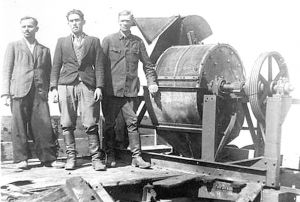Janowska

Janowska Bone Crushing Machine
The Janowska forced labour camp was located on 134 Janowska Road in the suburbs of the city of Lvov, known as Lemberg, during the German occupation, in the Galicia district, where thousands of Jews were murdered. The Germans established the labour camp in Janowska during September 1941, as an arms factory. Soon it was expanded into a complex of factories that served the Deutsche Austrungswerke (DAW -
The first Commandant of the camp was Fritz Gebauer, and his deputies were Gustav Wilhaus and Richard Rokita. In May 1942, Fritz Gebauer took over the command of the DAW camp, and Gustav Wilhaus was appointed Commandant of Janowska. A staff of between 12 and 15 SS officers administered the camp, and the majority of the guards were Ukrainians who had volunteered for service with the SS. At the beginning of November 1941, the Nazis asked the Chairman of the Lvov Jewish Council (Judenrat), Dr Joseph Parnes, to provide more workers for the camp. He refused and was executed. The camp underwent a change in March 1942, when the mass deportation of Jews from Eastern Galicia to the Belzec death camp began, Janowska was used as a transit camp, and some Jews were kept there, whilst others were deported to Belzec, and its murderous gas chambers. Continual selections took place at Janowska and those deemed unfit for work were also deported to Belzec. Later in the spring the Nazis expanded Janowska and the Lvov Judenrat tried to help the prisoners there by sending to them food packages, but hardly any of the packages reached the inmates. By the summer of 1942, thousands more Jews arrived in Janowska.
The living conditions in the camp were exceptionally harsh. Many prisoners committed suicide by hanging themselves in the barracks, rather than go on living. When the prisoners returned from work, the prisoners were made to run into the camp, Wilhaus and his assistant Freidrich Warzok singled out those Jews who showed signs of fatigue. These Jews were placed between the rows of barbed-
By mid-
One revolt did break out among the prisoners forced to exhume and burn the corpses, to conceal the evidence of the mass killings. On Friday, 19 November 1943, the rebels killed some guards, but most of them were caught and killed. One of the prisoners who escaped from this group of prisoners, who were part of Sonderkommando 1005, was Leon Weliczker, who gave evidence at the Adolf Eichmann Trial in Jerusalem during 1961.
The Soviets liberated Lvov on 26 July 1944 and carried out a number of investigations into the war crimes committed at Janowska; however, the precise number of victims murdered in Janowska will never be known, but estimates range from 100,000 to 200,000
Sources:
Robert Rozett and Shmuel Spector, Encyclopaedia of the Holocaust , Yad Vashem , Fitzroy Dearborn Publishers Chicago –London 2000
Leon Weliczker Wells, The Janowska Road, Holocaust Library, USHMM Washington DC, 1999
Photograph – USHMM Archive
Thanks to Duncan Price
© Holocaust Historical Society, December 15, 2024

